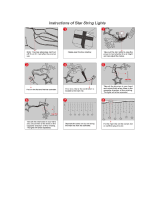
INSTALLATION AND USE MANUAL
Technical service - Rights reserved MCZ S.p.A. - Reproduction prohibited
INTRODUCTION .................................................................................................................................... 5
1. WARNINGS AND GUARANTEE CONDITIONS ..................................................................................... 6
1.1. SAFETY INSTRUCTIONS .................................................................................................................... 6
1.2. OPERATING WARNINGS .................................................................................................................... 7
1.3. WARRANTY TERMS ........................................................................................................................... 8
1.3.1. Limitations ................................................................................................................................. 8
1.3.2. Exclusions .................................................................................................................................. 8
2. INSTALLATION – UNDERSTANDING THE BASICS ............................................................................. 9
2.1. Pellets .............................................................................................................................................. 9
2.2. INSTALLATION ............................................................................................................................... 10
2.3. OPERATING AREA ........................................................................................................................... 10
2.4. CONNECTION TO THE EXTERNAL AIR INTAKE ................................................................................. 10
2.5. CONNECTION TO THE FLUE PIPE .................................................................................................... 11
2.6. OPERATING PROBLEMS CAUSED BY DRAUGHT DEFECTS IN THE FLUE .............................................. 13
3. INSTALLATION AND ASSEMBLY ...................................................................................................... 14
3.1. DRAWINGS AND TECHNICAL CHARACTERISTICS.............................................................................. 14
3.1.1. STAR Air .................................................................................................................................. 14
3.1.2. EGO Air ................................................................................................................................... 14
3.1.3. Technical characteristics ........................................................................................................... 15
3.2. INSTALLATION ............................................................................................................................... 16
3.2.1. Alcove installation .................................................................................................................... 16
3.3. MOBILE HOME INSTALLATION ........................................................................................................ 17
3.4. VENTING ........................................................................................................................................ 18
3.4.1. Avoiding Smoke and Odors ....................................................................................................... 18
3.4.2. Vent Configurations .................................................................................................................. 18
3.4.2.1. Wall outlet (method #1) .................................................................................................... 19
3.4.2.2. Wall outlet (method #2) .................................................................................................... 19
3.4.2.3. Installing into an existing chimney (method #3) .................................................................. 20
3.4.2.4. Installing into an existing fireplace chimney (method #4) .................................................... 20
3.4.2.5. Installing into an existing fireplace chimney (method #5) .................................................... 21
3.4.2.6. Installing into an existing chimney (method #6) .................................................................. 21
3.4.2.7. Installing through the ceiling vent (method #7) ................................................................... 22
3.4.3. Requirements for Terminating the Venting ................................................................................. 23
3.5. PREPARATION AND UNPACKING...................................................................................................... 25
3.6. LATERAL CLADDING ASSEMBLY ....................................................................................................... 27
3.7. INSTALLATION OF AIR FILTER ........................................................................................................ 29
3.7.1. Outside Air .............................................................................................................................. 29
3.8. MAKING THE ELECTRICAL CONNECTIONS ....................................................................................... 29
4. OPERATION ..................................................................................................................................... 30
4.1. PRE-LIGHTING WARNINGS .............................................................................................................. 30
4.2. PRE-LIGHTING CHECK .................................................................................................................... 31
4.3. LOADING THE PELLETS ................................................................................................................... 31
4.4. CONTROL PANEL/REMOTE CONTROL DISPLAY (accessory) ............................................................... 32
4.4.1. Control panel logic ................................................................................................................... 32
4.4.2. Remote control (accessory) ...................................................................................................... 34
4.4.3. General characteristics of the LCD remote control ...................................................................... 35
4.4.4. Type of batteries and replacement ............................................................................................ 35
4.5. SETTINGS TO CARRY OUT BEFORE FIRST LIGHTING ........................................................................ 35
4.5.1. Setting current day and time ..................................................................................................... 36
4.5.2. Setting the language ................................................................................................................ 38
4.6. FIRST LIGHTING ............................................................................................................................. 39
4.6.1. ON/OFF from the control panel or remote control (if purchased) ................................................. 39
4.6.2. Note: first ignition .................................................................................................................... 39






























